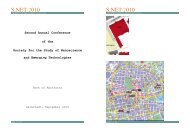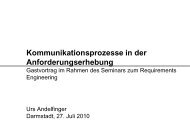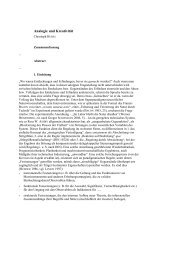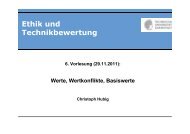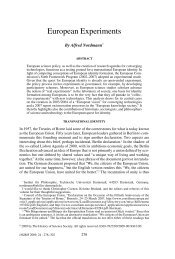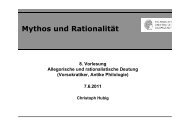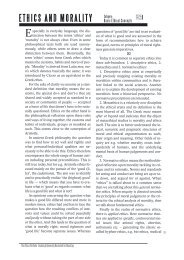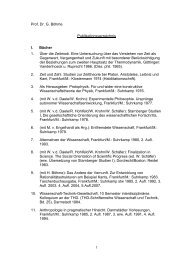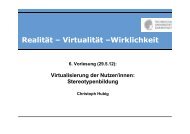If and Then: A Critique of Speculative NanoEthics - Common Sense ...
If and Then: A Critique of Speculative NanoEthics - Common Sense ...
If and Then: A Critique of Speculative NanoEthics - Common Sense ...
Create successful ePaper yourself
Turn your PDF publications into a flip-book with our unique Google optimized e-Paper software.
Nanoethics (2007) 1:31–46 45<br />
<strong>of</strong> humanity <strong>and</strong> perhaps just the one that has given<br />
rise to Enlightenment notions <strong>of</strong> autonomy <strong>and</strong><br />
consumer choice in the first place. For public debate<br />
<strong>and</strong> philosophical critique <strong>of</strong> this research program<br />
from within our contingently given, changeable yet<br />
ineluctable historical condition, there is no need to<br />
misleadingly validate a hypothetical future, to be<br />
“future-friendly,” credulous, visionary. Luckily, we<br />
do not even need to be particularly imaginative. 35<br />
References<br />
1. Amato I (1999) Nanotechnology – shaping the world atom<br />
by atom. National Science <strong>and</strong> Technology Council,<br />
Interagency Working Group on Nanoscience, Engineering<br />
<strong>and</strong> Technology, Washington<br />
2. Anders G (1956) Die Antiquiertheit des Menschen. Beck,<br />
München<br />
3. Anders G (1972) Endzeit und Zeitende: Gedanken über die<br />
atomare Situation. Beck, München<br />
4. Bostrom N, Toby O (2006) The reversal test: eliminating<br />
status quo bias in applied ethics. Ethics 116:656–679<br />
5. Bostrom N (2006) Welcome to a world <strong>of</strong> exponential<br />
change. In: Miller P, Wilsdon J (eds.) Better humans?<br />
The politics <strong>of</strong> human enhancement <strong>and</strong> life extension.<br />
DEMOS, London, pp 40–50<br />
6. Brul<strong>and</strong> K, Mowery, DC (2004) Innovation through time.<br />
In: Fagerberg J, Mowery D, Nelson R (eds) The Oxford<br />
h<strong>and</strong>book <strong>of</strong> innovation. Oxford University Press 2004,<br />
Oxford<br />
7. Bunting M (2006) There is no stop button in the race for<br />
human re-engineering. The Guardian, Monday, 30 January<br />
2006<br />
8. Caplan A (2006) Is it wrong to try to improve human<br />
nature? In: Miller P, Wilsdon J (eds) Better humans? The<br />
35 It is therefore that Jean-Pierre Dupuy <strong>and</strong> Jürgen Habermas<br />
do not care whether certain events happen or do not happen in a<br />
remote future – as far as they are concerned, they are happening<br />
already in that our conceptions <strong>of</strong> the self are changing [9, 14].<br />
As in Heidegger, so with Dupuy, the “catastrophe” is<br />
metaphysical, whether or not our changed conceptions yield<br />
any technological innovation whatsoever. (This might afford a<br />
more charitable reading also <strong>of</strong> the research program at Arizona<br />
State University, quoted in note 12 above.) As argued in<br />
Nordmann [28], I fully agree with this manner <strong>of</strong> avoiding the<br />
if-<strong>and</strong>-then. Indeed, it informs the present analysis: While I<br />
would not dare formulate moral maxims for future human, nonhuman,<br />
post-human beings, I can see that the enhancement<br />
discourse makes claims first upon my present attention, <strong>and</strong><br />
second on my more or less deficient body – claims that I can<br />
<strong>and</strong> must refuse, if only to resist an unwarranted attribution <strong>of</strong><br />
defectiveness.<br />
politics <strong>of</strong> human enhancement <strong>and</strong> life extension.<br />
DEMOS, London, pp 31–39<br />
9. Dupuy J-P (2005) The philosophical foundations <strong>of</strong> nanoethics:<br />
arguments for a method. Lecture at the Nanoethics<br />
Conference, University <strong>of</strong> South Carolina, 2–5 March 2005<br />
10. Gehring P (2006) Was ist Biomacht? Vom zweifelhaften<br />
Mehrwert des Lebens. Campus, Frankfurt<br />
11. Green J (2005) Presentation at the key technologies<br />
conference. DG Research, Brussels (September 19)<br />
12. Grunwald A (2004) Vision assessment as a new element <strong>of</strong><br />
the technology futures analysis toolbox. In: Proceedings <strong>of</strong><br />
the EU-US scientific seminar: new technology foresight,<br />
forecasting & assessment methods, Seville, 13–14 May<br />
2004<br />
13. Grunwald A (2006) Nanotechnologie als Chiffre der<br />
Zukunft. In: Nordmann A, Schummer J, Schwarz A<br />
(eds) Nanotechnologien im Kontext: Philosophische,<br />
ethische, gesellschaftliche Perspektiven. Akademische<br />
Verlagsgesellschaft, Berlin, pp 49–80<br />
14. Habermas J (2005) Die Zukunft der menschlichen Natur:<br />
Auf dem Weg zu einer liberalen Eugenik? Suhrkamp,<br />
Frankfurt. Compare the English edition The future <strong>of</strong><br />
human nature. Blackwell, 2003, London<br />
15. Hagner M (2006) Der Geist bei der Arbeit. Historische<br />
Untersuchungen zur Hirnforschung. Wallstein, Göttingen<br />
16. Hård M, Jamison A (2005) Hubris <strong>and</strong> hybrids: a cultural<br />
history <strong>of</strong> technology <strong>and</strong> science. Routledge, London<br />
17. Harris J (2006) Enhancement, justice, <strong>and</strong> rights. Princeton<br />
Lectures, James Martin Institute, 14–16 March 2006<br />
18. HLEG (High Level Expert Group) Foresighting the new<br />
technology wave (2004) Converging technologies: shaping<br />
the future <strong>of</strong> European societies. Office for Official<br />
Publications <strong>of</strong> the European Communities, Luxemburg<br />
19. Hughes J, LaTorra M (2006) WTA NEWS 3 November<br />
2006: News <strong>of</strong> the World Transhumanist Association http://<br />
transhumanism.org/index.php/WTA/rss_2.0/ accessed 14<br />
February 2007<br />
20. Hutchins E (1996) Cognition in the wild. MIT, Boston<br />
21. Jamison A (2006) Hubris or hybrids? On the cultural<br />
assessment <strong>of</strong> nanotechnology. EASST Review 25(3).<br />
http://www.easst.net/review/oct2006/jamison accessed 14<br />
February 2007<br />
22. Kurzweil R (2000) The age <strong>of</strong> spiritual machines. Penguin<br />
Books, New York<br />
23. Kurzweil R (2005) The singularity is near. Penguin Books,<br />
New York<br />
24. Miller P, Wilsdon J (2006) Stronger, longer, smarter, faster.<br />
In: Miller P, Wilsdon J (eds) Better humans? The politics <strong>of</strong><br />
human enhancement <strong>and</strong> life extension. DEMOS, 2006,<br />
London, pp 13–27<br />
25. Miller P, Wilsdon J (2006) The man who wants to live<br />
forever. In: Miller P, Wilsdon J (eds) Better humans? The<br />
politics <strong>of</strong> human enhancement <strong>and</strong> life extension.<br />
DEMOS, London, pp 51–58<br />
26. Moor J, Weckert J (2004) Nanoethics: assessing the<br />
nanoscale from an ethical point <strong>of</strong> view. In: Baird D,<br />
Nordmann A, Schummer J (eds) Discovering the nanoscale.<br />
IOS, Amsterdam, pp 301–311<br />
27. Müller S (2006) Minimal-invasive und nanoskalige<br />
Therapien von Gehirnerkrankungen: Eine medizinethische<br />
Diskussion. In: Nordmann A, Schummer J, Schwarz A





